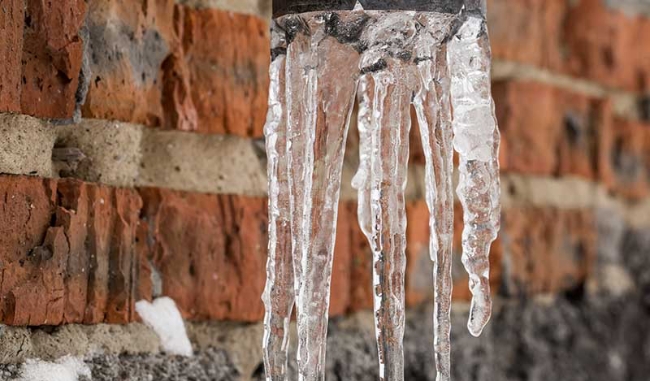Shielding Your Pipes from Cold Weather Damage: Key Approaches
Shielding Your Pipes from Cold Weather Damage: Key Approaches
Blog Article
We've found this post involving Winter Plumbing Precautions: Preventing Frozen Pipes below on the web and believe it made perfect sense to talk about it with you over here.

Winter can wreak havoc on your plumbing, especially by freezing pipes. Right here's just how to stop it from taking place and what to do if it does.
Intro
As temperature levels drop, the risk of frozen pipes rises, possibly leading to expensive fixings and water damage. Comprehending just how to stop frozen pipes is vital for home owners in cold climates.
Prevention Tips
Protecting prone pipelines
Wrap pipes in insulation sleeves or utilize heat tape to secure them from freezing temperatures. Focus on pipelines in unheated or exterior areas of the home.
Heating methods
Keep interior spaces effectively warmed, specifically locations with pipes. Open cabinet doors to allow warm air to flow around pipes under sinks.
How to identify frozen pipelines
Search for decreased water flow from faucets, uncommon smells or sounds from pipes, and visible frost on revealed pipelines.
Long-Term Solutions
Structural modifications
Take into consideration rerouting pipelines far from outside walls or unheated areas. Add extra insulation to attics, basements, and crawl spaces.
Upgrading insulation
Invest in premium insulation for pipes, attics, and walls. Proper insulation helps keep regular temperature levels and minimizes the danger of frozen pipes.
Shielding Exterior Plumbing
Garden tubes and exterior faucets
Disconnect and drain pipes garden hoses prior to winter season. Set up frost-proof faucets or cover outdoor faucets with shielded caps.
Comprehending Icy Pipelines
What creates pipelines to ice up?
Pipelines ice up when exposed to temperatures listed below 32 ° F (0 ° C) for prolonged durations. As water inside the pipelines ices up, it broadens, putting pressure on the pipeline walls and potentially creating them to burst.
Risks and problems
Icy pipes can bring about water supply interruptions, property damage, and expensive fixings. Ruptured pipelines can flood homes and trigger substantial architectural damages.
Indicators of Frozen Pipes
Identifying icy pipelines early can stop them from rupturing.
What to Do If Your Pipelines Freeze
Immediate actions to take
If you believe icy pipelines, maintain faucets open up to eliminate stress as the ice thaws. Use a hairdryer or towels taken in hot water to thaw pipelines slowly.
Final thought
Avoiding icy pipes needs aggressive steps and fast reactions. By recognizing the causes, indications, and safety nets, homeowners can secure their pipes throughout cold weather.
5 Ways to Prevent Frozen Pipes
Drain Outdoor Faucets and Disconnect Hoses
First, close the shut-off valve that controls the flow of water in the pipe to your outdoor faucet. Then, head outside to disconnect and drain your hose and open the outdoor faucet to allow the water to completely drain out of the line. Turn off the faucet when done. Finally, head back to the shut-off valve and drain the remaining water inside the pipe into a bucket or container. Additionally, if you have a home irrigation system, you should consider hiring an expert to clear the system of water each year.
Insulate Pipes
One of the best and most cost-effective methods for preventing frozen water pipes is to wrap your pipes with insulation. This is especially important for areas in your home that aren’t exposed to heat, such as an attic. We suggest using foam sleeves, which can typically be found at your local hardware store.
Keep Heat Running at 65
Your pipes are located inside your walls, and the temperature there is much colder than the rest of the house. To prevent your pipes from freezing, The Insurance Information Institute suggests that you keep your home heated to at least 65 degrees, even when traveling. You may want to invest in smart devices that can keep an eye on the temperature in your home while you’re away.
Leave Water Dripping
Moving water — even a small trickle — can prevent ice from forming inside your pipes. When freezing temps are imminent, start a drip of water from all faucets that serve exposed pipes. Leaving a few faucets running will also help relieve pressure inside the pipes and help prevent a rupture if the water inside freezes.
Open Cupboard Doors
Warm your kitchen and bathroom pipes by opening cupboards and vanities. You should also leave your interior doors ajar to help warm air circulate evenly throughout your home.

I ran across that write up about 6 Ways to Prevent Frozen Pipes when doing a lookup on the internet. Make sure you take the opportunity to distribute this write-up if you enjoyed it. Many thanks for your time. Kindly pay a visit to our blog back soon.
Click For More Info Report this page